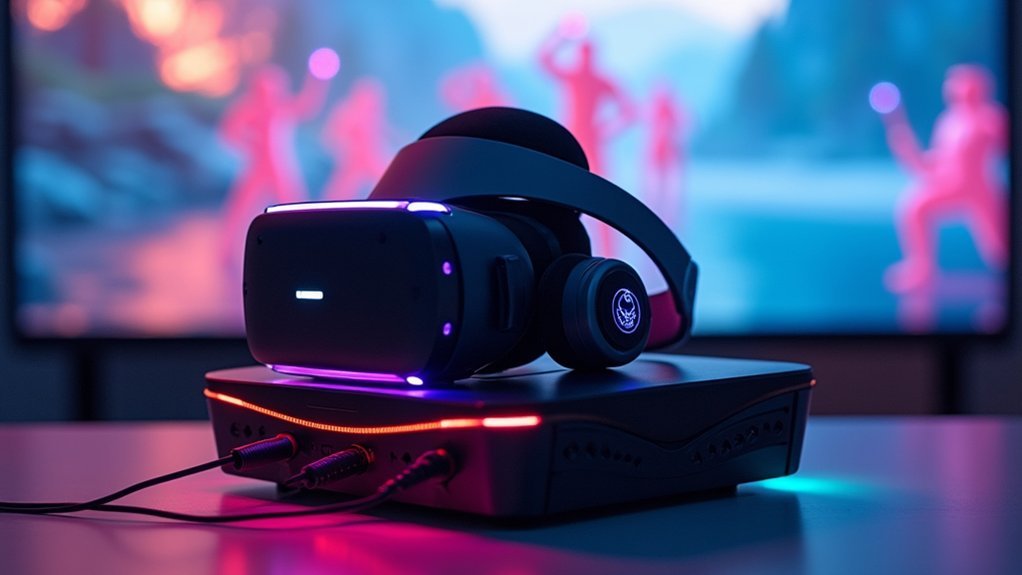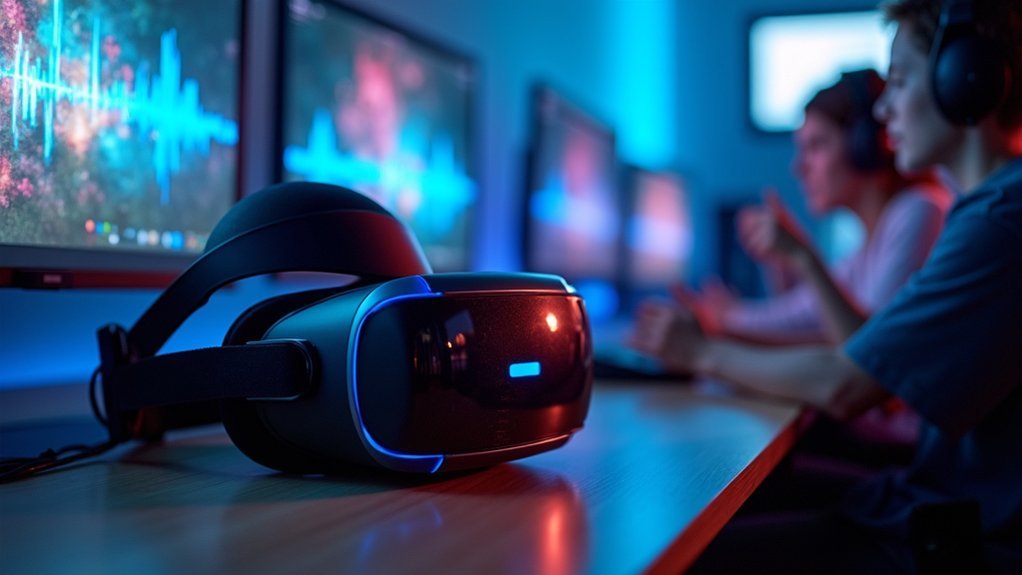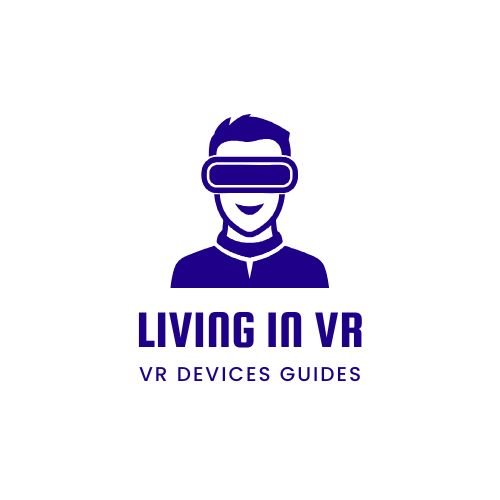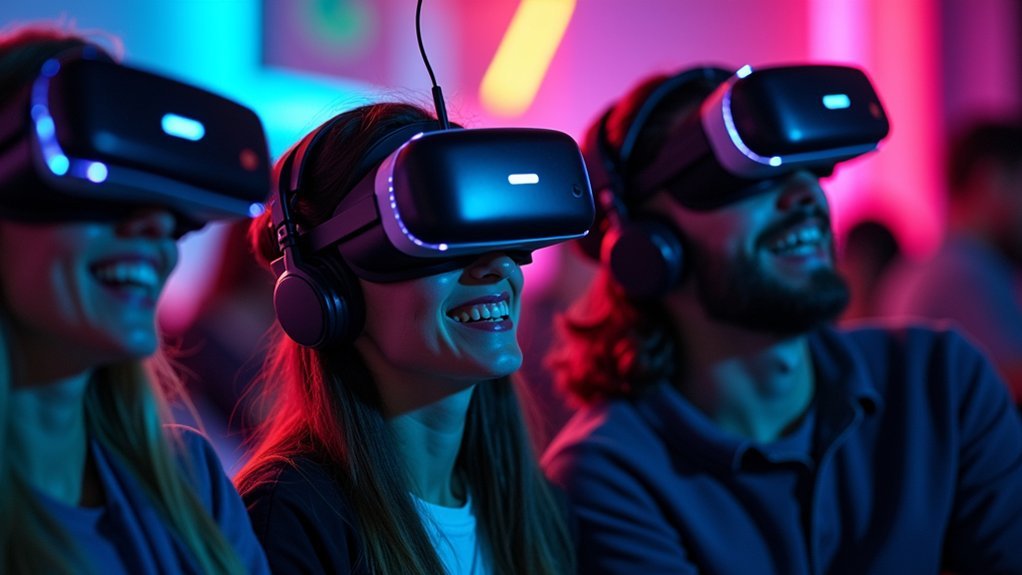You can implement voice chat for VR multiplayer games by using Photon Voice with Unity’s XR toolkit, which provides real-time spatial audio communication. Configure the Opus codec for superior audio quality and low latency, then attach audio sources to 3D objects for immersive spatial positioning. Set up your network architecture to handle player connections efficiently, ensuring cross-platform compatibility across different VR headsets like Vive Pro and Quest 2. This guide covers the complete implementation process.
Choosing the Right Voice Chat Solution for VR Applications

When developing VR multiplayer games, you’ll need to prioritize voice chat solutions that deliver exceptional audio quality and seamless real-time communication.
Focus on systems utilizing the Opus codec, which provides superior audio performance essential for immersive VR experiences. Solutions like Photon Voice exemplify this approach perfectly.
Select lightweight plugins offering essential features without unnecessary complexity.
Dissonance with Mirror networking demonstrates how streamlined integration enhances your development process.
You’ll want systems supporting seamless scalability, guaranteeing smooth performance as user loads increase—a hallmark of Photon Cloud infrastructure.
Prioritize continuous audio communication over push-to-speak functionality to maintain immersion.
Additionally, ascertain compatibility across various VR headsets, including Oculus Quest and Valve Index, maximizing your potential user base and ensuring broad accessibility for your VR multiplayer experience.
Setting Up Photon Voice for Unity VR Projects
Since you’ve selected Photon Voice as your VR chat solution, you’ll need to configure it properly within Unity to maximize its spatial audio capabilities.
The integration process is streamlined, allowing you to quickly add voice communication functionality to existing multiplayer systems without overwhelming complexity.
Start by importing the Photon Voice package and configuring the Opus codec settings for superior audio quality.
Import the Photon Voice package first, then optimize Opus codec configurations to achieve professional-grade audio quality in your VR application.
You’ll want to attach audio sources to 3D objects in your Unity scene, creating immersive spatial voice communication that enhances player interaction in VR environments.
The system supports various VR headsets including Vive Pro, Valve Index, Quest 2, and Windows Mixed Reality.
This compatibility guarantees your multiplayer VR experience delivers clear, crisp voice communication regardless of hardware, while maintaining performance across different network conditions for scalable user experiences.
Configuring Audio Quality With Opus Codec

You’ll want to leverage the Opus codec’s superior real-time audio optimization to deliver crystal-clear voice communication in your VR multiplayer environment.
The codec’s variable bit rate support lets you fine-tune audio quality between 6-510 kbps, ensuring you can balance fidelity with bandwidth constraints across different platforms.
Since Opus dynamically adapts to network fluctuations, you’re getting reliable voice chat that maintains clarity even when connection conditions change during gameplay.
Opus Codec Benefits
Although numerous audio codecs exist for voice communication, Opus stands out as the premier choice for VR multiplayer games due to its specialized optimization for real-time scenarios.
The Opus codec delivers exceptional audio clarity essential for multiplayer interactions, ensuring you’ll experience crystal-clear communication that enhances immersion. Its real-time voice communication capabilities minimize latency, preventing the audio delays that can break VR’s sense of presence.
You’ll benefit from Opus’s intelligent bitrate adaptation, which automatically adjusts quality based on network conditions to maintain stable connections. The codec supports everything from narrowband to fullband audio, giving you flexibility across different gaming scenarios.
Since Skype co-developed Opus, you’re getting enterprise-grade reliability. Its cross-platform compatibility means you can implement voice chat seamlessly across various VR devices and operating systems.
Real-Time Audio Optimization
When implementing Opus for VR multiplayer games, you’ll need to fine-tune several key parameters to achieve excellent real-time performance.
Start by configuring variable bitrates between 8-64 kbps, allowing dynamic adjustment based on current network conditions. Set frame sizes to 20ms for the best balance between latency and efficiency. Enable complexity scaling from 0-10, where lower values prioritize CPU performance over audio quality during intensive gameplay moments.
For multiplayer VR applications, configure the Opus codec’s application type to VOIP mode, which enhances speech transmission.
Implement adaptive bitrate algorithms that monitor network congestion and automatically adjust quality parameters. Use forward error correction sparingly to maintain low latency while providing basic packet loss protection.
These real-time audio optimization techniques guarantee consistent voice communication performance across varying network conditions and hardware capabilities in your VR environment.
Cross-Platform Quality Settings
Cross-platform VR multiplayer games demand consistent audio quality regardless of whether players connect from PC, mobile, or standalone headsets.
The Opus codec’s flexible bitrate range from 6 kbps to 510 kbps lets you configure ideal settings for each platform’s capabilities. You’ll want to set higher bitrates (128-256 kbps) for PC users with stable connections, while mobile and standalone headset users might require lower settings (32-64 kbps) to maintain performance.
Configure adaptive bitrate scaling that automatically adjusts based on network conditions. This guarantees consistent audio quality across all platforms without compromising spatial audio functionality.
Start with platform-specific presets: high quality for PC, medium for console VR, and refined low-latency settings for mobile. The codec’s efficiency maintains clear communication while preserving computational resources for VR rendering.
Implementing 3D Spatial Audio in Virtual Environments

Since immersive audio creates the foundation for believable virtual worlds, implementing 3D spatial audio transforms how players experience and interact within VR multiplayer environments.
You’ll attach audio sources to 3D objects in Unity, enabling users to perceive sound direction based on object placement and movement. Unity’s XR Interaction Toolkit and spatialization features help you create dynamic soundscapes that respond to user interactions in multiplayer VR settings.
The Opus codec guarantees high-quality audio transmission in real-time, delivering clear communication essential for effective multiplayer gameplay.
Real-time audio compression through Opus codec ensures seamless voice communication across multiplayer VR environments without latency or quality degradation.
You can leverage Unity’s spatialization capabilities to establish distinct audio zones, where sound volume and clarity vary based on proximity to sources. This 3D audio implementation considerably enhances engagement, particularly in FPS games where directional sound awareness influences strategy and player interactions.
Network Architecture for Player-Hosted VR Sessions
You’ll need to establish a solid network foundation that supports both local area networks and internet-based connections for your player-hosted VR sessions.
Your session host management system must handle player connections, disconnections, and data synchronization while maintaining the low latency required for real-time voice communication.
Setting up your local network properly guarantees that voice chat packets flow efficiently between all participants without creating bottlenecks that could disrupt the immersive experience.
Local Network Setup
When establishing a player-hosted VR session, you’re creating a decentralized network architecture that eliminates dependency on external servers while maintaining direct control over your multiplayer environment.
Your local network setup becomes the foundation for seamless voice chat integration and stable multiplayer sessions.
You’ll want to implement a robust networking framework like Mirror to manage player connections efficiently. This handles the complex networking tasks while you focus on gameplay features.
For voice chat functionality, integrate lightweight solutions like Dissonance, which works seamlessly with Mirror’s architecture.
Prioritize minimizing latency and optimizing round-trip times within your local network. Your architecture should accommodate varying user loads, scaling from intimate small groups to larger multiplayer sessions without compromising performance quality or communication clarity.
Session Host Management
At the core of player-hosted VR sessions lies a critical architectural decision: designating one participant as the authoritative session host who’ll manage game state synchronization and coordinate all player interactions.
Your session host management system determines the overall multiplayer experience quality, since the host’s network connection directly impacts latency for all participants.
You’ll need robust host migration capabilities to maintain gameplay continuity when hosts disconnect unexpectedly.
Implement peer-to-peer networking to reduce server dependency and achieve lower latency between players.
Your session management architecture should seamlessly handle room creation, player joining mechanics, and voice chat activation without disrupting the VR experience.
Design your system to automatically select hosts based on connection quality, ensuring peak performance for player-hosted sessions throughout the entire multiplayer experience.
Cross-Platform Compatibility Across VR Headsets
Since VR multiplayer games attract players using different headsets like Vive Pro, Valve Index, Quest 2, Focus 3, and Windows Mixed Reality devices, your voice chat system must work seamlessly across all these platforms.
Achieving cross-platform compatibility requires implementing voice chat solutions that utilize codecs like Opus, which delivers superior audio quality while minimizing latency during real-time communication.
You’ll want to focus on lightweight solutions such as Photon Voice that integrate easily with existing projects without excessive dependencies.
These systems allow players on different VR headsets to communicate effectively without additional complexity.
Guarantee your implementation includes global voice chat controls and automatic player connections to streamline the user experience across diverse hardware, ultimately enhancing player engagement and interaction in your multiplayer environment.
Managing Voice Chat in Local Network Multiplayer
When you’re setting up voice chat for local network VR multiplayer, you’ll need to configure your network architecture to handle real-time audio transmission between devices on the same local network.
Your primary focus should be optimizing audio quality while minimizing latency, which requires careful bandwidth management and proper codec selection.
You’ll also want to implement seamless audio routing that automatically connects all players in the session without complex setup procedures.
Local Network Configuration
Two primary advantages emerge when configuring voice chat for local network multiplayer VR games: reduced latency and enhanced audio quality.
When you’re setting up your local network configuration, you’ll leverage the same Wi-Fi connection to guarantee seamless communication between players. Photon Voice’s Opus codec delivers superior sound quality while maintaining real-time performance.
Your configuration process involves three essential steps:
- Session Management – Connect all players to the same Photon session using the advanced session system.
- Audio Controls – Enable or disable voice chat functionality globally to control user experience dynamically.
- Performance Testing – Monitor user loads and fine-tune settings to prevent potential performance issues.
This local network approach creates an ideal multiplayer environment where voice chat enhances gameplay without compromising VR performance.
Audio Quality Optimization
Although local network configurations provide the foundation for seamless voice chat, enhancing audio quality requires fine-tuning specific parameters within your VR multiplayer environment.
You’ll want to implement the Opus codec for superior audio transmission, ensuring crystal-clear communication that’s essential for immersive experiences. Configure continuous audio streams without push-to-talk functionality to maintain uninterrupted player conversations during gameplay.
Integrate 3D audio positioning to enhance spatial awareness, allowing players to perceive voices based on their virtual locations within the game world. This creates a more realistic communication experience where distant players sound farther away.
You should also establish global voice chat controls, enabling you to manage audio settings dynamically based on your session requirements and maintaining ideal performance across all connected devices.
Optimizing Performance for Large-Scale VR Applications
Since large-scale VR applications can quickly overwhelm standard networking solutions, you’ll need robust infrastructure that maintains performance as your user base grows.
Photon Cloud provides seamless scaling from a few to tens of thousands of users without performance dips, making it ideal for large-scale deployments.
To optimize your VR voice chat performance:
- Implement Opus codec for audio transmission to guarantee superior quality and low latency critical for immersive multiplayer experiences.
- Leverage dedicated servers and custom code plug-ins through Photon Enterprise Cloud to enhance connection stability and manage varying user loads effectively.
- Utilize 3D audio integration to spatially place audio streams in virtual environments, providing immersive experiences that scale with user count.
Ascertain your networking framework supports web sockets for smooth connectivity across VR and WebGL platforms.
Testing Voice Communication With XR Device Simulator
Once you’ve optimized your VR voice chat infrastructure, you need to test the implementation thoroughly before deploying to physical hardware.
The XR Device Simulator provides an effective solution for testing voice communication without requiring actual VR devices. You can simulate controllers and HMDs using mouse and keyboard input, creating a controlled testing environment for your multiplayer games.
Install the simulator through Unity’s Package Manager and integrate it with voice chat solutions like Dissonance.
Run multiplayer play mode sessions to evaluate audio quality and latency between virtual players. This approach lets you identify integration issues early in development, ensuring clear and responsive voice communication.
The simulator streamlines your testing workflow while helping you deliver polished VR experiences.
Troubleshooting Common VR Voice Chat Integration Issues
When voice chat integration problems arise in VR multiplayer games, they often stem from compatibility mismatches between your voice chat plugin and networking framework.
These incompatibilities can cause unreliable performance and frustrating user experiences.
To resolve integration issues effectively:
Effective integration issue resolution requires systematic verification of compatibility, proper audio configuration, and optimized network settings for seamless voice chat performance.
- Verify compatibility – Confirm your voice chat plugin works seamlessly with your chosen networking framework to prevent integration conflicts.
- Configure audio settings – Check audio input and output settings in both Unity and your VR headset configurations to confirm proper voice communication setup.
- Optimize network settings – Verify your network settings support low-latency connections, as high latency disrupts voice chat quality during multiplayer sessions.
Test functionality with limited users first, then regularly update your voice chat plugin to access bug fixes and performance improvements.
Frequently Asked Questions
How Do You Voice Chat With Friends While Playing Games?
You’ll use integrated voice chat solutions like Photon Voice or lightweight plugins such as Dissonance. Connect all players to the same session, ensuring compatibility with your VR headset for seamless real-time communication.
How to Use Voice Chat in VR Chat?
You’ll need to enable your microphone in VR Chat’s settings menu. Simply speak normally – the game uses open mic by default. You can mute yourself using the quick menu or gesture controls when needed.
Can You Talk to Other Players on Oculus?
Yes, you can talk to other players on Oculus through built-in voice chat features. Most multiplayer VR games automatically enable voice communication when you join sessions, letting you speak naturally without needing push-to-talk buttons.
Is There Voice Chat on VR?
Yes, you’ll find voice chat in most VR platforms and games. You can talk to other players using your headset’s built-in microphone, whether you’re playing multiplayer games or socializing in virtual spaces.





Leave a Reply